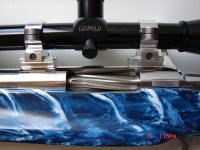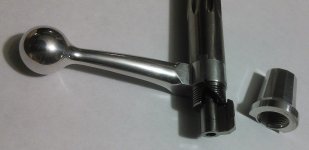Chuck's Shooting
I bought a bunch of powder from michael about 15yrs ago and we met at a range in lubbock texas. I was able to shoot both of the rifles at that time and was simply AMAZED when they put 125 speers, noslers, or sierras through virtually the same hole. The wind was absolutely screaming and we were still consistently shooting in the 1's and LOW 2's. When it came time to build myself a new bench rifle i also wanted to be different and went with a 30x44. Not near as cool as the 30-30, but i already had a good .308 reamer with .050 freebore and a fitted neck. it too would shoot "cheap" bullets extremely well. Glad you are getting back into shooting michael!!!
Chuck's memory serves him well, except for a couple of things. First of all this was in 2009. Earlier post show the powder transactions here on benchrest.
I will describe that day in some detail. The wind was in the 30mph range, with gust probably close to 50mph. The target frames that are used there outside of Lubbock were weighted down with brake rotors. The wind was so strong that the backstops blew over. The backing material was busted and blew out of one of the frames. Flags were not set, because we simply met to make the powder transaction and shoot a few groups. The tails would have been straight out the whole time anyway.
Chuck would put 15 to 20 staples in a 8.5" X 11" target, and it would be ripped off the backstop before he could fire the first shot. This happened about three times, and I can't even remember how we got the targets to stay.
Now Chuck says that WE were shooting in the 1's and low 2's. That is true as a combined effort, but it leads one to believe that I was also shooting 1's. I only shot one group, and it was .210", and I was extremely pleased with that group considering the conditions. However, that group came after Chuck shot a series of four 1's. I went back and looked at older post so I could see the groups sizes. His first group with the HV was a .147", then he shot a .190" group with the LV, followed by a .130" with the light gun. I did not document his other HV group, but all I know is that he never shot anything other than 1's. Together we did shoot a teen agg. in high winds without flags. These groups were shot with four different bullets. Speer 125 TNT, Sierra 135 Matchkings, Sierra 125 Pro Hunters, Berger 125. He shot one group with each of the listed bullets. I only shot one group, the .210" with the Bergers.
The funniest thing I remember was how Chuck looked at me each time the next shot went through the same hole and said "this is a good gun". This would happen through the whole group with each gun. I paid no attention to how he was holding the gun. Probably should have.
I have never in my life seen someone shoot the way he did. It was like being in a underground tunnel, despite the horrible conditions.
Michael





